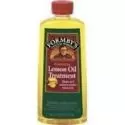Paste Wax, Polish or Oil: Which is Best?

In truth, paste wax, polish and oil each have their place, but they cannot be used interchangeably.
Here, then, is a quick review of why and when you should use each one.
Paste Wax – This is a true furniture finish, for it dries, hardens and protects the wood. At one time the Roycrofters reportedly used nothing more than paste wax over their dyed wood, but we have since learned that paste wax by itself is a weak finish. Applied atop either new or old shellac, however, it can provide additional protection. For that reason I recommend a coat of paste wax over any original Arts & Crafts finish. Never topcoat an original finish with lacquer, polyurethane, linseed oil, tung oil or any finish other than paste wax. It is the only topcoat that does not change the appearance and reduce the value of an antique with its original finish.
Not all waxes are created equal, however. Look for quality waxes, such as Minwax, Johnson & Johnson, Butcher’s or Renaissance, for they contain more carnauba, the hardest of the waxes. Avoid beeswax and other soft or semi-paste waxes, for they can give you a false sense of security without providing enough protection. Plus, since they do not harden like carnauba wax, they tend to smear.
Furniture Polishes – This multi-million dollar industry spawns new products every year promising to protect, shine or even ‘feed’ your furniture. If a piece of furniture has a strong finish, including a topcoat of paste wax, then it does not need to be fed. For regular dusting, just use ordinary lemon oil and a clean, soft cloth. The lemon oil does smell good, but its primary purpose is to dampen the cloth so that it will pick up dust. Unlike goopy polishes or soaps, it does not leave a streaky film.
Oil – What we are referring to here is tung oil, linseed oil, teak oil, Danish oil, or any other kind of oil-based finish that dries and hardens in the wood. These are fine for finishing new wood, but are not intended to be applied atop an existing finish, especially shellac or paste wax. Never use them in place of paste wax over an original Arts & Crafts finish.
Note: Dark-tinted paste wax has become almost impossible to find, but if you want a simple recipe for tinting clear paste wax to help disguise minor blemishes and scratches, see our video “Preserving Arts & Crafts Finishes.”
Here is the link:
https://artsandcraftscollector.com/videos/
Good Luck!
Bruce

